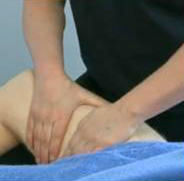The Pros and Cons of Massages for Runners

RUNNER'S WORLD Article
Research finally reveals just what massages can—and can't—do for runners.
First, let's set the record straight: Science doesn't support some ingrained beliefs about massage. "It can't push toxins out of the muscles and into the bloodstream," says JoEllen Sefton, Ph.D., associate professor of kinesiology at Auburn University, who has practiced massage therapy. "There's no physiological way that can happen." Nor does it appear to flush lactic acid from muscles, says Crane, who analyzed muscle samples after subjects cycled to exhaustion and then received a 10-minute massage. "People assumed that because lactic acid feels burny, and massage reduces pain, then it must clear away lactic acid," he says.
What massage does do is apply moving pressure to muscles and other tissues such as tendons, ligaments, and fascia (which sheaths muscles like a sausage casing). "That energy softens fascia tissue and makes clenched muscles relax," Sefton says. It also removes adhesions between fascia and muscles (places where the two stick together and restrict muscles' movement). That's especially great news for runners, who rely on limber joints and muscles for pain-free peak performance.
Science's biggest discovery is what massage can do for athletic recovery. Studies published in the Journal of Athletic Training and the British Journal of Sports Medicine found that massage after exercise reduced the intensity of delayed onset muscle soreness (DOMS)—that is, the peg-legged feeling you get two days after your marathon. And other research suggests that it improves immune function and reduces inflammation. Emory University researcher Mark Rapaport, M.D., found that just one massage treatment resulted in an increased number of several types of lymphocytes (white blood cells that play a key role in fighting infection) while also decreasing levels of cortisol (the "stress hormone" linked to chronic inflammation). "More research is needed, but it's reasonable to think that massage could help runners taxed from exertion," Rapaport says. It may also help curb chronic diseases. "We know that systemic inflammation is associated with a lot of deleterious effects, such as heart attack and stroke, and that it predisposes people to cancers," he says.
Crane's research, published in Science Translational Medicine, found less inflammation in massaged limbs—and 30 percent more of a gene that helps muscle cells build mitochondria (the "engines" that turn a cell's food into energy and facilitate its repair). "What we saw suggests that massage could let runners tolerate more training, and harder training, because it would improve their recovery and speed up their ability to go hard two days later," he says.
Studies on rabbits confirm Crane's prediction. At Ohio State University, Thomas Best, M.D., Ph.D., put a device on exercised animals that simulates massage and records the applied pressure. "We've shown a 50 to 60 percent recovery in muscle function compared with no massage," he says.
The new evidence is so convincing that even the researchers have made massage a regular part of their routines: Crane, Rapaport, and Best have all become devotees as a result of their findings, and they recommend that runners follow suit. Regular massage can boost recovery and be a valuable training tool to help you run your best. "Muscle stiffness can throw off your gait, which leads to problems over time," Sefton says. "And by getting a sense for how your body should feel when everything is in balance, you're more likely to notice small issues before they turn into chronic problems." Even beginning runners can benefit from massage, because alleviating the soreness that comes with starting a new sport makes people more likely to stick with it.
Can't afford weekly treatments? Self-massage with foam rollers and other tools like tennis balls can be beneficial in between visits. They can also help runners prep for workouts, since they loosen muscles. "Just don't overdo the pressure," says Sefton, who notes that even a person's body weight on a foam roller sometimes applies too much force (and causes muscles to tighten in defense). "Bodywork just before a race or hard workout should be light," says massage therapist Anna Gammal, who worked with athletes at the 2012 Olympics. "We don't want muscles to feel sore or overworked."
After a race or grueling workout, a therapist may go deeper in order to help with recovery—or not. It all depends on the individual, Gammal says. "Through talking with the athlete and using touch, a therapist will determine the state of the muscle and if it's best to use light strokes or deep-tissue techniques to treat an athlete in a safe and productive way."
See also:
»Newer topics:
»Older topics:
»
![]() Common Running Injuries
Common Running Injuries
Common Running Injuries
![]() Common Running Injuries
Common Running Injuries
Common Running Injuries
See also:
»Newer topics:
»Older topics:
»
![]() Happy Hammies
Happy Hammies
four basic exercises for hammies
![]() Happy Hammies
Happy Hammies
four basic exercises for hammies
See also:
»Newer topics:
»Older topics:
»
![]() Stay on Course
Stay on Course
Common steps to keep healthy - in sports
![]() Stay on Course
Stay on Course
Common steps to keep healthy - in sports
See also:
»Newer topics:
»Older topics:
»
![]() Foam Rolling for Runners
Foam Rolling for Runners
foam-roller ---- deep-tissue-massage
![]() Foam Rolling for Runners
Foam Rolling for Runners
foam-roller ---- deep-tissue-massage




